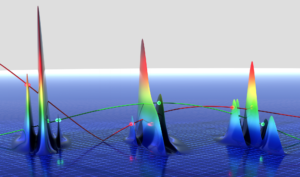Faculty: Paul Berman (Physics, Emeritus), Steven Cundiff (Physics, EECS), Parag Deotare (ECE) Kevin Kubarych (Chemistry), Alex Kuzmich (Physics) Jennifer Ogilvie (Physics), Georg Raithel (Physics), Vanessa Sih (Physics), Liuyan Zhao (Physics)
Summary (Prepared by Hui Deng)
Michigan has a tradition of excellence and leadership in spectroscopy, or more generally using light to measure, control and create quantum states of matter that dates back well over fifty years. More recently, Michigan faculty have been pioneers and leaders in coherent nonlinear spectroscopy, both in frequency domain by Steel and in the time-domain by Cundiff, Ogilvie, and Kubarych. The technique of multidimensional coherent spectroscopy is providing a bridge between frequency- and time-domain methods. Other nonlinear and quantum optical spectroscopic methods are also well established to study spins, magnetism, quantum materials, and single or many-body quantum states. These spectroscopic methods also enable creation and control of quantum states in matter by light, as exemplified by Steel’s work on quantum dots as qubits, and Cundiff and Kira’s work on quantum spectroscopy to create few-body quantum states.

Complementary to using coherent light to control matter, optical structures can be used to modify the vacuum fields and thereby control light-matter interactions. This include using nano-pillar structures to create and control single photon emitters by Ku, Deotare and Deng, using cavities to control chemical reactions in quantum chemistry by Kubarych, and using cavities to create and control quantum gases of polaritons with the potential of forming graph network simulators for NP-hard problems.
Other nonlinear and quantum optical spectroscopic methods are also well established to study spins, magnetism, quantum materials, and single or many-body quantum states with Sih (spintronics), Zhao (correlated electrons), Deng (polaritonics) and Deotare (excitonics) labs.
